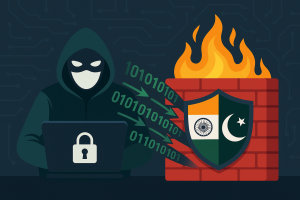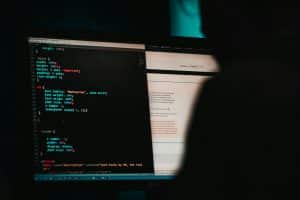Introduction: The AI Arms Race in Cybersecurity
In 2023, a deepfake audio clone of a CEO’s voice tricked a finance officer into transferring $35 million to hackers. This incident, reported by the FBI, underscores a chilling reality: AI hacking tools in 2025 are no longer theoretical—they’re here, evolving faster than defenses can keep up. As cybercriminals weaponize machine learning for attacks, defenders are deploying AI-driven systems to detect, block, and outsmart them. This blog dives into the dual-edged sword of AI in cybersecurity, featuring real-world case studies, cutting-edge tools, and expert strategies to stay ahead.
Part 1: How Hackers Weaponize AI in 2025
1.1 Deepfake Phishing: The Rise of Synthetic Social Engineering
Case Study: In early 2024, a European energy company lost $2.1 million after hackers used AI-generated video calls impersonating executives. Tools like DeepFaceLab and Respeecher cloned voices and faces in minutes.
How It Works:
- Voice Cloning: AI models like OpenAI’s Whisper analyze short audio clips to replicate speech patterns.
- Video Manipulation: GANs (Generative Adversarial Networks) create hyper-realistic fake videos.
Image Suggestion:
Caption: Deepfake technology blurs the line between real and synthetic media.
Stat: 74% of cybersecurity professionals reported AI-driven phishing attacks in 2024 (Ponemon Institute).
1.2 AI-Generated Malware: Self-Evolving Threats
Case Study: ChatGPT-4.5 was exploited to write polymorphic malware that changes its code to evade detection.
Tools Used by Hackers:
- WormGPT: A dark web LLM (Large Language Model) designed for malicious code generation.
- AI-Powered Fuzzers: Automatically discover software vulnerabilities (e.g., AutoSploit).
Expert Insight:
“Hackers now use reinforcement learning to train malware—it learns from failed attacks and adapts,” says Dr. Sarah Chen, Threat Intelligence Lead at CrowdStrike.
1.3 Automated Vulnerability Scanning at Scale
Example: Tools like Sybil AI scan millions of lines of code in minutes, identifying zero-day exploits.
Impact:
- 60% faster vulnerability discovery compared to manual methods (MITRE, 2024).
External Link: MITRE’s 2025 AI Cyber Threat Report
Part 2: How Defenders Fight Back with AI
2.1 AI-Powered Threat Detection
Tool Spotlight: Darktrace’s Antigena
- Uses unsupervised learning to detect anomalies in real-time.
- Neutralized a ransomware attack at a U.S. hospital by isolating infected devices within seconds.
Image Suggestion:
Caption: AI-driven threat detection in action.
Stat: AI reduces breach detection time by 90% (IBM Cost of a Data Breach Report 2024).
2.2 Deepfake Detection: AI vs. AI
Tool Spotlight: Microsoft Video Authenticator
- Analyzes video metadata and pixel patterns to spot deepfakes.
- Deployed by governments to combat election misinformation.
Internal Link: How to Spot Deepfakes: A Guide for Businesses
2.3 Predictive Defense: Stopping Attacks Before They Happen
Case Study: Google’s Chronicle uses machine learning to predict phishing campaigns by correlating dark web data with network traffic.
How It Works:
- Trains on historical attack patterns to forecast future threats.
Quote:
“Predictive AI is like a weather forecast for cyberattacks,” explains Raj Samani, Chief Scientist at McAfee.
Part 3: The Ethical and Legal Battlefield
3.1 The Dark Web’s AI Marketplaces
Example: Platforms like Genesis AI sell pre-trained models for DDoS attacks, priced in cryptocurrency.
Key Features:
- Plug-and-play AI tools requiring minimal technical skill.
External Link: Europol’s Report on AI in Cybercrime
3.2 Regulations Struggling to Keep Up
EU’s AI Act (2025): Bans malicious AI tools but faces enforcement gaps.
Challenge:
- How to regulate open-source AI frameworks (e.g., TensorFlow) used for both good and bad.
Part 4: Tools and Resources for Defenders
4.1 Top AI Defense Tools in 2025
- CylancePROTECT: Uses AI to block zero-day malware.
- Vectra AI: Detects hidden attackers in cloud and data center environments.
- IBM QRadar Advisor: Automates incident response with Watson.
Internal Link: Best AI Cybersecurity Tools for 2025
4.2 Training Your Team
Courses:
- SANS SEC595: “Machine Learning for Cybersecurity Professionals.”
- Coursera: “AI-Driven Threat Hunting” (offered by Palo Alto Networks).
Image Suggestion:
Caption: Upskilling teams is critical to counter AI-powered threats.
Conclusion: Staying Ahead in the AI Arms Race
The battle between AI hacking tools in 2025 and defensive systems will define cybersecurity’s future. While hackers innovate ruthlessly, defenders can leverage AI’s speed, scalability, and predictive power to protect assets. Collaboration, regulation, and continuous learning are non-negotiables in this high-stakes game.








